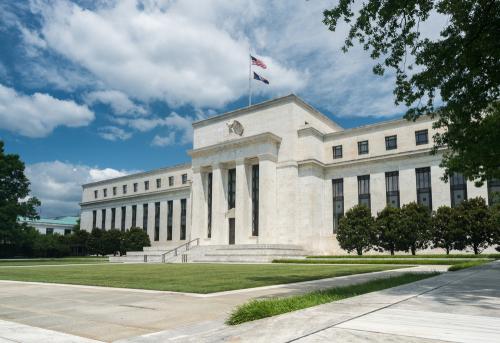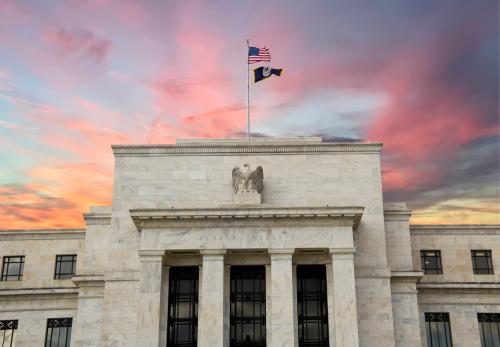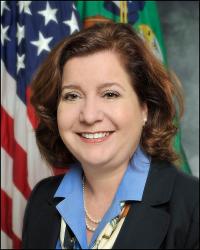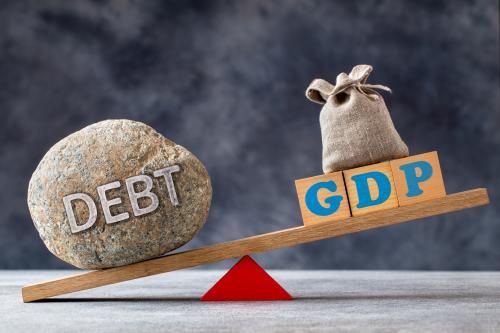In an effort to quell post-pandemic inflation, the Federal Reserve raised short-term interest rates eleven times since March 2022, with the federal funds rate now at its highest in over 20 years. Historically, such interest rate hikes—or even the suggestion of hikes—have triggered financial crises in emerging markets and developing economies. But, so far, that hasn’t happened. In this episode of the Brookings Podcast on Economic Activity, Şebnem Kalemli-Özcan and Filiz Unsal discuss their new study, which examined how improved monetary policy credibility in these countries may have improved their resilience to American financial trends.
- Listen to the Brookings Podcast on Economic Activity on Apple, Spotify, or wherever you like to get podcasts.
- Learn about other Brookings podcasts from the Brookings Podcast Network.
- Sign up for the podcasts newsletter for occasional updates on featured episodes and new shows.
- Send feedback email to [email protected].
Transcript
[00:00:00]
[music]
EBERLY: I’m Jan Eberly, James R. and Helen D. Russell Professor of Finance at Northwestern University.
STEINSSON: And I’m Jón Steinsson, Chancellor’s Professor of Economics at the University of California, Berkeley.
EBERLY: We’re the coeditors of the Brookings Papers on Economic Activity, a semiannual academic conference and journal that pairs rigorous research with real time policy analysis to address the most urgent economic challenges of the day.
STEINSSON: And this is the Brookings Podcast on Economic Activity, where we share conversations with leading economists on the research they do and how it will affect economic policy.
[00:00:47]
STEINSSON: High inflation over the last couple of years has led to a number of rounds of interest rate hikes by the Federal Reserve, which at least in the past has had major global impacts. On this episode. We’ll hear from Şebnem Kalemli-Özcan. the Neil Moskowitz Endowed Professor of Economics at the University of Maryland, and Filiz Unsal, head of the Structural Policy Analysis Division at the Economics Department of the Organization for Economic Co-operation and Development, OECD.
Their paper titled “Global Transmission of Fed Hikes: The Role of Policy Credibility and Balance Sheets,” finds that at least so far, emerging markets and developing economies haven’t seen significant negative repercussions from recent U.S. interest rate hikes. They’ll be interviewed by Gian-Maria Milesi-Ferretti, senior fellow with the Hutchins Center on Fiscal and Monetary Policy, who’s an expert on global monetary policy.
EBERLY: Yeah, this episode of inflation and rate hikes in the U.S. has been different than previous episodes in many ways. And of course, that’s very true for emerging markets, as you were just mentioning, Jón. The inflation rose post-COVID rather than coming from a credit-based overhang and overheating. There’s the war in Ukraine that’s contributed globally. And the paper suggests that both lower debt and also greater policy credibility have helped to ease the burden on emerging markets. What’s your perspective on the experience in emerging markets, Jón? You have some related work on this topic.
STEINSSON: Yeah, it’s been really fascinating. And honestly, I’ve been pleasantly surprised at just how resilient the emerging market countries have been over the past few years. The Fed has raised interest rates by really a substantial amount, about five percentage points. In the past, this has usually led to a wave of crises in emerging markets. The most prominent example being the interest rate hikes in the early 1980s when Paul Volcker was chair of the Federal Reserve. In that case, those hikes were followed by a series of very serious crises in Latin America in 1982.
[music]
EBERLY: Gian-Maria, Şebnem, and Filiz will take us through why emerging markets have been more resilient to this series of rate hikes. So let’s turn it over to them.
[00:03:11]
MILESI-FERRETTI: So thank you, Jan and Jón. I am Gian-Maria Milesi-Ferretti of the Hutchins Center on Fiscal and Monetary Policy of the Brookings Institution. And I’m very happy to welcome two esteemed guests and two old friends to the podcast today. Şebnem Kalemli-Özcan of the University of Maryland.
KALEMLI-ÖZCAN: Hi, Gian-Maria. Thanks for having me.
MILESI-FERRETTI: And Filiz Unsal of the Organization for Economic Co-operation and Development.
UNSAL: Hi, Gian-Maria. It’s a pleasure to join here today.
MILESI-FERRETTI: So, I was asked to serve as the discussant for your new paper entitled “Global Transmission of Fed Hikes The Role of Policy Credibility and Balance Sheets,” at this fall’s Brookings Papers and Economic Activity conference. And I’m very excited to get to continue our conversation on your work today. Thank you both for joining me for this discussion.
And I will start with a question first, Şebnem. As our listeners surely know, the Federal Reserve has raised interest rates over the course of the last year in response to high inflation in the U.S. In the past, emerging market economies have had negative reactions to Fed hikes or even the suggestion of future hikes. Can you describe some of those episodes and what you would have expected to see in emerging markets following the recent round of hikes?
[00:04:39]
KALEMLI-ÖZCAN: Of course. And here the key word is exactly as you said, Gian-Maria, the suggestion of Fed hikes can even do damage. Right? And to remember such an event we just go back to May 2013, known as Taper Tantrum, when the Federal Reserve chairman at that time, Ben Bernanke, gave a speech on the possibility of the start of tightening without even doing actual tightening. And that led a flurry capital outflows from emerging markets, especially the fragile emerging markets known as fragile five, and also increase in risk spreads.
In fact, this is generally what happens. Before 2013, you can go to 1990s that the Fed hike started in 1994, led the Asian financial crisis. Before that, ‘70s and ‘80s, Volcker disinflation led to Latin American financial crisis. And that generally happens when Fed hikes we see this phenomena called “sudden stop” by international economists. So, there is a sudden stop in emerging markets, meaning the global investors stop investing in emerging markets, and then capital flow reversals, which means capital gets out of emerging markets.
The financial markets jargon for that is the dollar comes home effect. Why dollar comes home? Because Fed is hiking, that means higher return to dollar, dollar’s going back to United States, that means it’s getting out of emerging markets. So that is what we call sudden stop and capital flow reversals from emerging markets.
And this time around, if you go back to 2020, 2021, 2022, a lot of people were expecting the same phenomena to happen to emerging markets. And this didn’t happen so far, of course. We don’t know what the future holds, but so far as of 2023, this doesn’t happen. And it is interesting because, the Fed did increase a lot in less than two years. Less than two years we are witnessing a 5.5 percentage point hike in the policy rate by Fed.
So, none of this happened and this is what we are trying to do in the paper. Explain what happened in the past to emerging markets when Fed hike, and this didn’t happen recently, and why this didn’t happen.
MILESI-FERRETTI: Thank you, Şebnem. And if I can have just a short clarification follow up, maybe for our listeners that are a little bit less well versed in international finance and macroeconomics. So can you describe in just very basic terms what it means for capital to leave emerging markets? What type of financial operations are we talking about? Is it firms that had set up shop there that decide to leave, or is it investors? How does that work in practice?
[00:07:45]
KALEMLI-ÖZCAN: Yeah, this is very important because this is exactly how we think about prices and quantities moving together. So, this is why I mentioned financial market people call this phenomenon “dollar comes home,” that means wherever a dollar invested in emerging markets, it leaves. So this can be into government bonds, Right? For example, Mexican government might be issuing a bond that Americans invested their dollars in that bond—that comes home, meaning they sell that bond. Right? For the government.
Same thing happen for firms, right? Some large corporates in countries like Brazil, Mexico, Argentina, Korea might be borrowed in the international market, again in dollars. And then dollar comes home to the United States means those type of firms wouldn’t be able to find investors to invest in those bonds that they used to borrow.
But then, of course, banks are very important here, too, because a lot of emerging markets, they don’t have that large corpus. I mean, they have, but not that many that can go and issue a bond in the international market. So most of the capital is going to be intermediary to banks.
And during these type of events, emerging market banks are also going to witness a drying up of dollars. Right? Which means capital in that sense, when banks borrow. So generally people don’t think is all this is not just capital, this is just money, but it’s the same thing, right? Because U.S. banks borrow dollars, this money, but then those dollars go and invest in projects. Right? Banks might be lending them to smaller firms in their country or to households or still can be financing investments.
All this type of money financing capital is leaving when we talk about these events, when you say Fed is hiking, American investors coming home, American investors bring the dollars home. We are talking about emerging markets. Governments, banks, and firms are all being in a situation that their funding dries up.
MILESI-FERRETTI: Thank you. That is very clear. Thank you very much. And I will follow up with a question for Filiz. We haven’t seen a financial crisis in the major emerging markets so far. And in your paper, one of your main arguments is that an important factor in this resilience is improved credibility of central banks in these countries. And that it would be great if you could explain how you measured that and what is credibility and how this, how your credibility has translated into improved resilience.
[00:10:35]
UNSAL: Thanks, Gian-Maria. This is important part of the paper ultimately. So, we measure policy credibility with the new index I developed with my coauthors when I was at the IMF on monetary policy frameworks. So, the index covers all the key elements of monetary policymaking from how the monetary policy is designed, implemented, and communicated. And to some of the legal elements such as the powers and responsibilities of the central bank with respect to monetary policy.
So, to cover all these different essential elements of monetary policymaking in a deep way, we designed a granular set of criteria, and assessed them using public information collected manually from central banks, laws, and websites.
So, at the end, the index captures various important patterns across countries and over time about monetary policymaking and hence its credibility covering 50 countries over 2007 and 2021.
Improved monetary policy frameworks plays a critical role in bringing economic resilience for two fundamental reasons. First, a well-established monetary policy framework provides the frame of reference that guides sound and consistent policymaking and safeguards policy continuity. It also serves as a useful vehicle for steering policymakers on various issues and hence limit discretionary or substandard practices or policy mistakes.
Second, monetary policy credibility aids the public and the markets, informing policy expectations, reduces uncertainty, and ultimately makes monetary policy more effective.
So, it’s the measure of both improved policymaking and the trust it instills in the public and markets alike, which are both important for building and maintaining economic resilience to shocks.
MILESI-FERRETTI: Thank you, Filiz. And if I may ask, how does this change in monetary policy? Institutions relate to the way countries in the emerging world have chosen to manage their currency? So, have we seen shifts in that area with respect to the previous decades, to the past century that is associated with these shifts in monetary policy credibility?
[00:13:12]
UNSAL: For sure. Actually, it’s very difficult to manage your currency in a consistent and coherent way, while monetary policy has also its own objectives in terms of managing inflation and also providing some macroeconomic stability. So, in that sense, countries actually very early on realized these tradeoffs of how difficult it is to manage all different objectives with only one tool and therefore shifted their focus exclusively on providing macroeconomic stability, which they do through keeping inflation under control.
So, we have seen over the years that the number of countries that are aiming or trying to control exchange rate going down. Now, of course, there are cases where there is also a bit of a shift in the economic thinking that some not systemic interventions to the foreign exchange market to control the currency might be useful in some exceptional cases where there’s disorderly market conditions, where the financial markets are showing excessive volatility.
In these cases, foreign exchange intervention could be useful, but just to be used on a temporary basis and only to limit excessive fluctuations in the foreign exchange market. We have seen very successful implementation of these in some of the emerging market countries like Brazil and Mexico in the recent past.
MILESI-FERRETTI: Thank you, Filiz. This is great. Let me move to another question, this time for Şebnem. A second variable that your paper looks at that is assessed to be important for measuring resilience is the extent of borrowing in foreign currency. So, in the paper, you note that emerging markets where large firms are less reliant on borrowing in foreign currency have performed better when the U.S. has raised interest rates. Can you explain in simple terms why this is likely to be the case?
[00:15:17]
KALEMLI-ÖZCAN: Of course. And this goes exactly to the heart of the tradeoff Filiz has been mentioning. So these concepts, of course, are related. The reason why emerging markets borrow in dollars—you don’t have to just think this in terms of firms, you can think the entire country, governments, banks, firms—why they cannot borrow in their own currency, but why they have to borrow in dollars is because there is no trust in their own currency. Right? Why investors should be keeping that currency that they expect always will be less and less value?
And what does it mean a country that with high inflation, low monetary policy credibility, and like always depreciating currency, has to provide investors with some sort of excess returns. Otherwise, why on earth investors should be investing in that low value, depreciating asset. I mean, would you invest in a house that electricity doesn’t work, the water doesn’t work, and there’s always this sense of you have to fix everything? You wouldn’t. This is the same concept, right?
And that’s exactly why it is very important to see that the declining dollar debt, decline in dollar borrowing, goes together with improved monetary policy credibility. We actually showed these concepts related and there’s a negative relationship. And that’s exactly how it should work when you gain monetary policy credibility.
When you improve your monetary policy framework, when you gain monetary policy credibility, what is happening? Not just that you target your inflation and you keep your inflation expectations anchored. This is a narrow definition of monetary policy credibility.
[00:17:02]
As Filiz just explained, we are doing something way broader than that, that has never been done in this literature actually. When we say monetary policy credibility, countries gaining monetary policy credibility, they are doing what they say. Right? So going back to Filiz’s example, if they are not targeting the exchange rate, if they are not using their one tool—interest rate—to manage the exchange rate, that means the have monetary policy credibility. That’s going to help them not just having lower inflation expectations, but also the investors believe that, Oh, these guys know what they are doing. They are not going to let me have an asset that is going to keep depreciating. So I should actually lend these guys in local currency because they are on top of their game. And that is going to mean their dollar debt is going to decline, of course. Right?
So we always have to think this in terms of shares. It’s not that countries are borrowing less, they are borrowing less in dollars. That means they are going to borrow more in their own currency, which is exactly why the investors is willing to do because now that investor is going, Oh, that’s a good investment for me, this is not going to lose value. Why? Because the guys have monetary policy credibility, they know what they are doing.
So that’s exactly the circular thing we are capturing with this new, effective, exogenous measure. And we, of course, look at as this supporting part of our narrative what is going on that affects debt, dollar debt.
Now, we are looking at firms. Why do we focus on firms and not just the country as a whole or not just governments or banks? Because I just told you, any sector in a country can borrow in dollars. The reason why we focus on firms goes back to your earlier question, Gian-Maria, how emerging markets borrow? Now, this is very important because there is a big difference here between emerging markets and developing countries. So when we talk about a country like Mexico, Brazil, Turkey versus Lebanon, Pakistan, Ghana, we are in very, very different worlds. So let me first clarify that.
In emerging markets, the borrowing is done by equal shares. When you look at the amount of external debt, capital flowing into emerging markets, you see it’s a third, third, third. Third of it is borrowed by emerging market governments, third of it by emerging market banks, third by emerging market corporates. In developing countries, poorer countries, this is not the case. Over 80%, overwhelming share, is going to be borrowed by governments. So, first of all, that’s a very big difference.
[00:19:35]
Now, focusing back on emerging markets, when we think this third, third, third, amount of money coming into country, third goes to banks, third goes to corporates, third goes to government. What we have seen in the last decade or so, the amount going to government is becoming more and more local currency. Exactly because of this improved monetary policy credibility. And the amount going to the banks are required to be hedged by regulation. Why? Because emerging market banks went through crisis after crisis, and they understand very well that if they are borrowing in dollars, there has to be a hedging instrument, hedging that currency risk because they have to pay back dollars, the foreign investors.
So, that leaves me the third group, the third of the borrowing: the corporates. Corporates are still borrowing in dollars. So we see the remaining vulnerabilities really in the corporate sector borrowing in dollars on hedge, because we know very well from the literature that corporates are not hedging this where banks are required to hedge the currency risk by regulation and governments are borrowing in local currency. That means the vulnerability in terms of the dollar debt that feeds back to this loop of you have lower monetary policy credibility, you have to borrow higher, affects debt pool. That is really concentrated in the corporates right now.
That’s why we focus on corporate dollar debt and we show that this also came down to a level that is not typical in emerging markets. The numbers we show are around 12 to 15% of GDP, or total debt. This is something much lower than the 60%, 70% numbers be used to see in ‘80s and ‘90s. So we focus on that.
And we showed that in fact the historical bad effects of Fed hikes concentrated on countries that have not only suffered from low monetary policy credibility, but of also the countries whose corporate sectors heavily indebted in dollars. So those are the two factors that explain the historically bad effects of Fed hikes.
And we argued that the second reason why recent episode of Fed hikes didn’t lead to these bad effects in emerging market is together with improved monetary policy credibility they decrease the dollar debt in their corporate sector.
MILESI-FERRETTI: Thank you, Şebnem. Just again, for our less well-informed listeners on this general topic, why is it so bad to have dollar debt when the Fed hikes? What is the danger?
[00:22:16]
KALEMLI-ÖZCAN: The bad thing about dollar debt is exactly the fact that you have to be paying that back with local currency. So, at the end of the day, regardless of when you are paying that dollar debt, you have to be converting your earnings, your assets, your liquidity that is in your local currency to dollars to pay back investors that invested in you in terms of dollar. That’s your dollar debt.
Of course, during these events when Fed hikes, that is something harder and harder to do because of course your exchange rate depreciating vis-à-vis the dollar now is going to be harder and harder to pay back that dollar debt with your currency earnings.
[00:23:02]
UNSAL: So just to add on that, if you allow me, Gian-Maria. You know, we always say in economics that the central banks are the lender of last resort. And of course, we would like to see them that way. And one of the major problem with borrowing in effect that is that your central bank not becomes not a lender of last resort because they just cannot provide banks with foreign exchange. And that’s a big problem, because that means that in the case of financial crisis or the big financial distress in the banking system, there’s almost nothing central bank could do. And none of the countries, I imagine, would like to find themselves in that position.
MILESI-FERRETTI: Thank you Filiz, and thank you, Şebnem. And let me move to one more question, this time for Filiz. In the paper you have documented that there is an increase in resilience for major emerging markets. Yet we read that there are a lot of poorer countries that are struggling to pay their debts, that are negotiating with creditors to reduce it. What can we say about poorer countries more generally? Are they still very vulnerable to tightening in U.S. monetary policy?
[00:24:23]
UNSAL: Yeah, Thanks, Gian-Maria. So in this paper, of course, we are focusing on a very specific channel, which is that how the global financial markets are transmitting specific monetary policy shocks from the U.S. to the rest of the world.
Now, of course, some of these poorer, low-income countries are usually less connected to the global financial markets, which is both a curse and a blessing. In terms of the channel that we emphasize, since they are less connected to the global financial markets, they are less vulnerable to these type of shocks in the global markets. But at the same time, of course, this means that they cannot benefit the global wealth that exists in the financial markets either. And that’s why it’s a curse.
And of course, that’s not a good thing. And given that these countries need a lot of resources for various reasons, and also, of course, to develop further, many of them actually have been becoming more and more connected to the global markets while improving their policymaking, while at the same time improving the structure of their economies and keeping foreign exchange vulnerabilities under check, such as Uganda.
But of course, there are some others that are still connected to the global financial markets, but haven’t managed effectively enhancing their monetary policymaking or still living with high and fixed vulnerabilities.
Of course, the other issue is that they might be affected through trade channel. For example, tighter global financial conditions could bring lower commodity prices, which sometimes affect poorer countries disproportionately as they export more raw materials. There might also be some impact through aid, but these are not the channels we cover in this paper.
[00:26:09]
KALEMLI-ÖZCAN: Let me also add something there, Gian-Maria, if I may. I, of course, fully agree with Filiz, and I would like to add the scale of this issue. Because when we say the poor countries, and again, they might be affected from other channels and also they might be still yet to be seen affected. Right? I mean, this didn’t happen. But even if you look at what happened, like the IMF original help, which is around 60 billion in 2021, and then the recent defaults of countries like Lebanon and then Ghana, Kenya, Sri Lanka needing money. So when you put all this together, you wouldn’t be passing something like hundred billion. I mean, IMF lending capacity is a trillion. They are willing to make a third of that available, 300 billion.
So, I’m giving these numbers because just one of the five large emerging markets rolled over $200 billion of debt in the financial markets. So it is very important what Filiz is saying, we have to separate emerging markets and developing economies here because there is no IMF, or no U.S. Federal Reserve that can save emerging markets if four of them go under. And this is going to actually come back to global financial markets.
So, the only solution is market solution to emerging market issue, because they are just so big. These guys are around a trillion to about 1.5 trillion economies; 35% of GDP in solidity of bank debt. So the fact that they will be rolling over this in the middle, not just COVID, but also these Fed hikes, definitely lends a lot of support to our story. They wouldn’t be able to do that. They wouldn’t be able to go back to financial markets. And I just gave you one example. I’m not going to give names, but just one country is rolling over a debt that is the entire help of IMF to these poor countries.
[00:27:53]
So, in that sense, it is extremely important that we see this trend going, these countries do improve their monetary policy credibility further and further. And hopefully at some point poorer countries will also join. Because the only way these large emerging markets can weather these shocks, these risks ____ shock that comes through financial markets is again with financial markets. So that’s the blessing and the curse thing.
So, there blessing is going to be the financial markets because there is no institution big enough to be able to save these guys right now. They are just so big. They are more than half of the world’s GDP. And the only way they are going to be on the good side of the financial markets and use the blessing is through improved monetary policy credibility.
UNSAL: Yeah, also this reminds me that, of course, there’s a large literature on when countries should open their capital account, but perhaps our paper can also provide some insights there in the sense that for some of these countries that are planning to be more connected to the global financial markets, perhaps it’s a good idea to keep their fixed vulnerabilities in check and improve monetary policy framework and monetary policy making first before moving in that for the poorer countries.
MILESI-FERRETTI: Very much so. I want to thank Şebnem and Filiz for this super interesting conversation and very interesting paper. I really encourage you to go and read it after you’ve listened to this podcast. Thank you.
[music]
KALEMLI-ÖZCAN: Thanks, Gian-Maria.
UNSAL: Thank you, Gian-Maria. It was great seeing you today.
[music]
STEINSSON: Once again, I’m Jón Steinsson.
EBERLY: And I’m Jan Eberly.
STEINSSON: And this has been the Brookings Podcast on Economic Activity. Thanks to our guests for this great conversation and be sure to subscribe to notifications about new releases of this podcast.
EBERLY: The Brookings Podcast on Economic Activity is produced by the Brookings Podcast Network. Learn more about this and our other podcasts at Brookings dot edu slash podcasts. Send feedback to podcasts at Brookings dot edu, and find out more about the Brookings Papers on economic activity online at Brookings dot edu slash BPEA.
STEINSSON: Thanks to the team that makes this podcast possible, including Kuwilileni Hauwanga, supervising producer; Fred Dews, producer; Gastón Reboredo, audio engineer; with the support from Shannon Meraw and Chris Miller of Economic Studies at Brookings. Show art was designed by Katie Merris at Brookings, and promotional support comes from our colleagues in Brookings Communications.










Commentary
PodcastHow have Fed interest rate hikes affected other national economies?
November 9, 2023